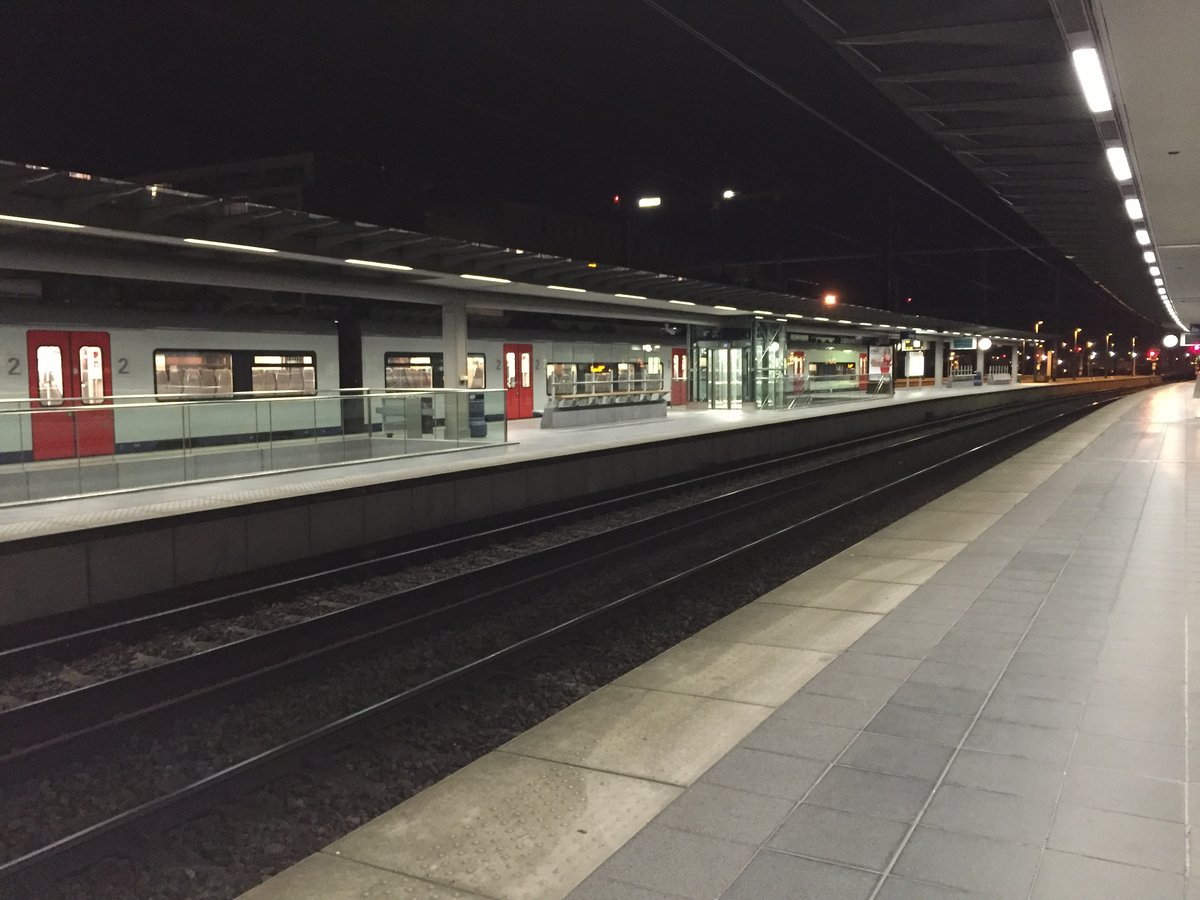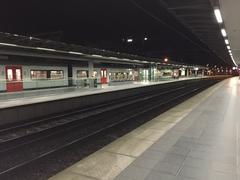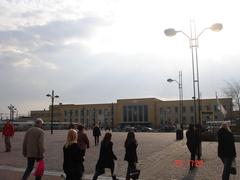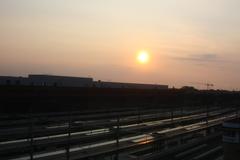
Brugge Railway Station: Visiting Hours, Tickets, and Travel Guide
Date: 14/06/2025
Introduction
Brugge Railway Station is the primary gateway to the enchanting city of Bruges, Belgium. Established in 1838, the station has played a pivotal role in connecting Bruges to national and international destinations, while offering modern conveniences and easy access to the city’s UNESCO-listed historic core (Wikipedia: Timeline of Bruges; Wikipedia: Brugge railway station). This guide provides detailed information on visiting hours, ticketing, accessibility, facilities, architectural history, nearby attractions, and essential travel tips to help you make the most of your visit to Bruges.
Table of Contents
- Introduction
- Visiting Hours and Ticket Information
- Accessibility and Amenities
- Getting to Bruges City Center
- Historical Overview
- Architectural Styles and Modernization
- Visitor Facilities and Services
- Nearby Attractions
- Events and Community Integration
- Sustainability and Future Developments
- Frequently Asked Questions (FAQs)
- Key Tips and Summary
- Sources
Visiting Hours and Ticket Information
Station Opening Hours:
Open daily from 5:00 AM to 11:00 PM. Some overnight train services may be available.
Ticket Counters:
Staffed counters operate from 6:00 AM to 10:00 PM. Self-service ticket machines are available throughout the station and accept major payment methods.
Online Tickets:
Tickets can be purchased in advance via the Belgian Railways website or the NMBS/SNCB app. Discounts are available for youth, seniors, and group travelers.
Tourist Information Office:
Located inside the station, open daily from 9:00 AM to 6:00 PM (extended hours during peak seasons). Provides maps, tickets, and travel assistance.
Accessibility and Amenities
The station is fully accessible, featuring:
- Elevators, ramps, and tactile guidance paths
- Accessible restrooms and baby-changing facilities
- Wheelchair-friendly platforms and passageways
- Staff assistance available upon request
Additional amenities include:
- Secure luggage storage lockers (various sizes)
- Free Wi-Fi throughout the station
- Bicycle rental services and covered racks
- Cafés, convenience stores, and souvenir shops
- Digital information displays with real-time schedules
Getting to Bruges City Center
Brugge Railway Station is about 1.5 kilometers from Bruges’ historic center:
- Walking: 15–25 minutes via scenic, well-marked paths to Markt Square and the Belfry
- Bus: Local De Lijn buses depart frequently from the adjacent terminal (5-minute ride)
- Taxi: Taxi stands are located outside the main entrance
- Bicycle: Rental points available; Bruges is bike-friendly
Historical Overview
Early Railway Development
Brugge Railway Station opened in 1838, shortly after Belgium’s first public railway, establishing Bruges as a key node in the expanding national network. This connection was crucial in reviving the city’s economy after centuries of decline (Wikipedia: Timeline of Bruges).
Architectural Evolution
- Original Station: Located at ’t Zand Square (1838), designed by Auguste Payen, reflecting utilitarian 19th-century railway architecture (Wikipedia).
- Growth and Relocation: As Bruges grew as a tourist destination, a larger, ornate station was built in 1879, followed by a move outside the city walls in 1939 to preserve the medieval core.
- Current Design: The present station, inaugurated in 1939, exemplifies the International Style—emphasizing functionality, clean lines, and minimal decoration (Wanderlog: Historic Buildings and Sites in Bruges).
Economic and Urban Impact
The railway’s arrival revitalized Bruges in the late 19th and early 20th centuries, reconnecting it to national and European trade and tourism circuits (World Guides: Bruges History Facts and Timeline).
Wartime and Postwar Developments
During both world wars, the station was strategic for logistics and suffered damage. Postwar modernization included electrification and infrastructure upgrades, ensuring its continued importance.
Modern Transport Integration
Brugge Railway Station is now a major hub, serving over 10 million passengers annually. Direct trains connect Bruges to Brussels, Ghent, Antwerp, and the Belgian coast. International travelers can reach Bruges easily via transfers at Brussels-South (Get Lost in Wanderlust).
Architectural Styles and Modernization
Early Buildings and Urban Impact
The station’s evolution mirrors Bruges’ broader urban history. The move from ’t Zand to its current location outside the medieval walls was a deliberate effort to safeguard Bruges’ unique heritage (SpottingHistory).
International Style and Modern Upgrades
Designed by Josse and Maurice Van Kriekinge, the current station’s International Style is characterized by horizontal lines, large windows, and a focus on practicality (Wikipedia). Modernization projects between 2004 and 2009 expanded tunnels, improved accessibility, and added underground parking for cars and bicycles, supporting sustainable, multimodal travel.
Visitor Facilities and Services
- Waiting Areas: Spacious, heated indoor rooms and outdoor seating in Station Park
- Retail and Food: Convenience stores, cafés, and food vendors, especially during events like the Bruges Sand Festival
- Luggage Services: Automated lockers and staffed left-luggage office for oversize items
- Hygiene: Clean, modern restrooms, including accessible and family facilities
Nearby Attractions
Brugge Railway Station is ideally positioned for easy access to Bruges’ most famous sites:
- Belfry of Bruges: Iconic medieval tower with panoramic city views (15-minute walk)
- Markt Square: Central plaza with historic buildings and vibrant cafés
- Béguinage: Peaceful UNESCO-listed courtyard and museum
- Canals: Picturesque waterways perfect for scenic walks and photography
For guided tours and canal boat rides, visit the onsite tourist office.
Events and Community Integration
The station is a vibrant community hub, hosting markets and festivals like the Zandfeesten (Bruges Sand Festival), which stretches from the station to ‘t Zand square. Public spaces in and around the station often feature exhibitions, performances, and pop-up events.
Sustainability and Future Developments
Ongoing redevelopment emphasizes green spaces (e.g., Station Park), improved cycling infrastructure, and enhanced accessibility, all while respecting Bruges’ UNESCO World Heritage status (Visit Bruges: World Heritage City).
Frequently Asked Questions (FAQs)
Q: What are the station’s opening hours?
A: Daily from 5:00 AM to 11:00 PM. Some overnight services are available.
Q: Where can I buy tickets?
A: At staffed counters, self-service machines, or online via the Belgian Railways website.
Q: Is Brugge Railway Station accessible?
A: Yes, with elevators, ramps, tactile paving, and accessible restrooms.
Q: Are there luggage storage options?
A: Yes, automated lockers and a staffed left-luggage office are available.
Q: What attractions are nearby?
A: The Belfry, Markt Square, Béguinage, and the canals are all within walking distance.
Q: Are guided tours available?
A: Yes, bookable at the tourist office for city walks and canal boat tours.
Key Tips and Summary
- Plan ahead: Purchase train tickets online during peak travel times.
- Accessibility: The station is fully equipped for travelers with reduced mobility.
- Explore on foot or bike: Bruges is compact and walkable, with excellent cycling infrastructure.
- Visit the tourist office: For up-to-date event information, maps, and guided tour bookings.
- Sustainability: Make use of cycling and public transit options for eco-friendly travel.
Brugge Railway Station effortlessly blends modern functionality with respect for Bruges’ medieval heritage, providing seamless access to one of Europe’s most captivating cities (Visit Bruges: Mobility; SpottingHistory).
Sources
- Timeline of Bruges, 2023, Wikipedia (Wikipedia: Timeline of Bruges)
- Brugge Railway Station, 2024, Wikipedia (Wikipedia: Brugge railway station)
- Historic Buildings and Sites in Bruges, 2023, Wanderlog (Wanderlog: Historic Buildings and Sites in Bruges)
- Bruges History Facts and Timeline, 2023, World Guides (World Guides: Bruges History Facts and Timeline)
- Is Bruges Worth Visiting?, 2023, Get Lost in Wanderlust (Get Lost in Wanderlust)
- World Heritage City Bruges, 2023, Visit Bruges (Visit Bruges: World Heritage City)
- Historic Centre of Brugge, 2024, SpottingHistory (SpottingHistory)
- Bruges Mobility, 2024, Visit Bruges (Visit Bruges: Mobility)
- OVPM – Brugge, 2023, Organisation of World Heritage Cities (OVPM)













































































